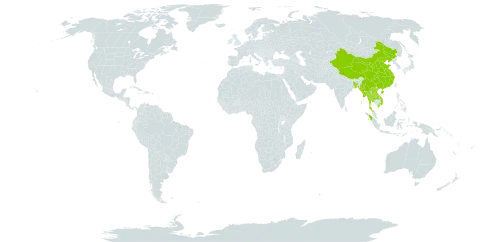Glabrous annual with fibrous roots. Stems solitary or tufted, acutely 4-5-ribbed, smooth, 10-35 cm by ¼-½ mm, the base clothed with 1-2 short-bladed sheaths. Leaves much shorter than the stems, rather rigid, falcate, flat, abruptly acuminate, scabrid on the margins in the upper part, 1-2 mm wide; ligule absent. Inflorescence subcompound to decompound, very loose, with several to numerous spikelets, 4-6 cm long. Involucral bracts 3-4, setaceous, often excurved, the lowest ½-2½ cm. Primary rays 3-6, erecto-patent, filiform, angular, smooth, up to 4 cm. Spikelets solitary, oblong-lanceolate, strongly com-pressed, acute, ferrugineous, 4-6 by c. 1½ mm. rachilla broadly winged. Glumes exactly distichous, very small, thinly membranous, glabrous, ovate, rather obtuse, minutely apiculate just below the apex, acutely keeled, with curved keel, distinct midnerve and nerveless sides, 1½-2(-2½) by c. 1½ mm. Stamens 2(-3); anthers oblong, ½(-1) mm. Style triquetrous, pyramidally thickened at the base, glabrous, 1-1½(-2) mm; stigmas 3, much shorter than the style. Nut trigonous, narrowly obovoid or obovoid, cuneate at the base, shortly stipitate, minutely umbonulate, more or less verruculose, whitish or stramineous, 3/5-7/10 by ⅓-½ mm; epidermal cells isodiametric to suboblong.
More
Annuals. Culms tufted, 10-30 cm tall. Leaf 1/4-1/3 as long as culm; sheath apex obliquely split, mouth margins membranous and pale brown; leaf blade linear, 1-2.5 mm wide, slightly curved, both surfaces scabrous with appressed short pubescence or glabrescent, apex acute. Involucral bracts 3 or 4, leaflike, to 2.8 cm, basalmost ca. 3 × as long as glumes, apically attenuate. Inflorescence a compound anthela; rays many. Spikelets solitary, ovoid to oblong-ovoid, 3-6 × 1.5-2.5 mm, slightly compressed, with basal 1 or 2 glumes empty. Glumes reddish brown, broadly ovate, ca. 2.5 mm, not shiny, glabrous, 1-veined forming an abaxial keel, apex mucronate. Stamens 3. Style 3-sided, not ciliate, basally inflated; stigmas 3. Nutlet white, obovoid, ca. 0.7 mm, 3-sided, verruculose. Fl. and fr. Aug-Sep.
